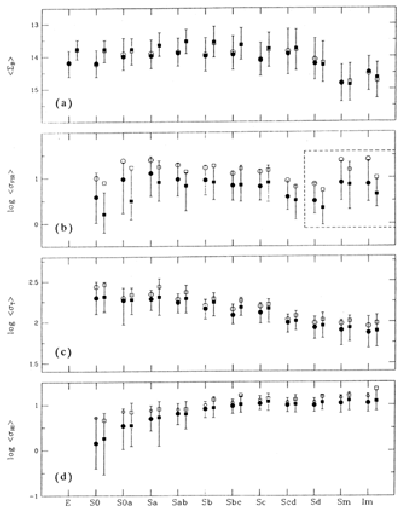Copyright © 1994 by Annual Reviews. All rights reserved
| Annu. Rev. Astron. Astrophys. 1994. 32:
115-52 Copyright © 1994 by Annual Reviews. All rights reserved |
The optical luminosity LB is a parameter of scale. Like the linear size, the range of median LB values characteristic of classical galaxies varies only slightly, until the latest types, where the distinctiveness of the dwarfs becomes evident (Figure 2b). The ellipticals here are slightly brighter than spirals.
LUMINOSITY FUNCTION
Holmberg's survey (1958)
included photometric parameters for both
magnitude and diameter with which he investigated the surface
brightnesses of galaxies and studied the effects of internal
extinction. Because internal extinction causes a sytematic change in
the observed surface brightness (and color) as a function of
inclination, we adopt a definition of surface magnitude that attempts
to account for extinction. As mentioned above, the issues of internal
extinction are still under significant debate
(Disney et al. 1989).
Figure 3a shows the global surface
brightness within D25,
DISK SURFACE BRIGHTNESS AND SCALE LENGTH
 (L). In their study of the
Virgo cluster
(Binggeli et al. 1985),
they derive the luminosity function
(L). In their study of the
Virgo cluster
(Binggeli et al. 1985),
they derive the luminosity function
 (L, T) for
each morphological type separately. The range of luminosities representative
of the classical galaxies is seen to be similar, as in
Figure 2b,
with the later spirals and dwarfs showing a characteristic decrease and being
clearly separate. Binggeli et al. find that while the brightest
galaxies are ellipticals, the most common galaxies are the dE's. Because
of morphological segregation, they conclude that
(L, T) for
each morphological type separately. The range of luminosities representative
of the classical galaxies is seen to be similar, as in
Figure 2b,
with the later spirals and dwarfs showing a characteristic decrease and being
clearly separate. Binggeli et al. find that while the brightest
galaxies are ellipticals, the most common galaxies are the dE's. Because
of morphological segregation, they conclude that  (L, T) cannot be
universal. We discuss the effects of morphological segregation in
Section 4.
(L, T) cannot be
universal. We discuss the effects of morphological segregation in
Section 4.
 B.
The distribution of
B.
The distribution of  B is nearly constant for the E, S0 and
classical spiral galaxies, but distinguishes clearly the late dwarf
categories Sm and Im. We emphasize again that,
as discussed by
Disney and Phillipps
(1983),
current catalogs are biased against systems of low surface brightness, and
some of the relative constancy across most of the classical
galaxy sequence may be due to catalog selection.
B is nearly constant for the E, S0 and
classical spiral galaxies, but distinguishes clearly the late dwarf
categories Sm and Im. We emphasize again that,
as discussed by
Disney and Phillipps
(1983),
current catalogs are biased against systems of low surface brightness, and
some of the relative constancy across most of the classical
galaxy sequence may be due to catalog selection.

Figure 3. Same as Figure 2, for
(a) optical (blue) surface brightness  B, (b) log FIR surface
density
B, (b) log FIR surface
density  FIR,
(c) log total mass surface density
FIR,
(c) log total mass surface density  T,
(d) log HI surface density
T,
(d) log HI surface density  HI.
Dashed lines delineate the types with significantly fewer data.
HI.
Dashed lines delineate the types with significantly fewer data.